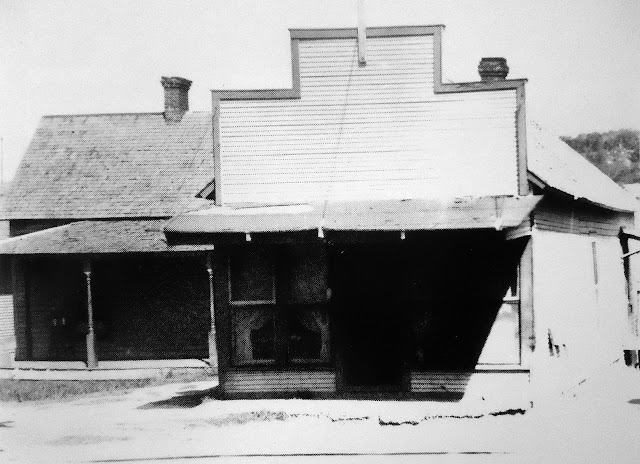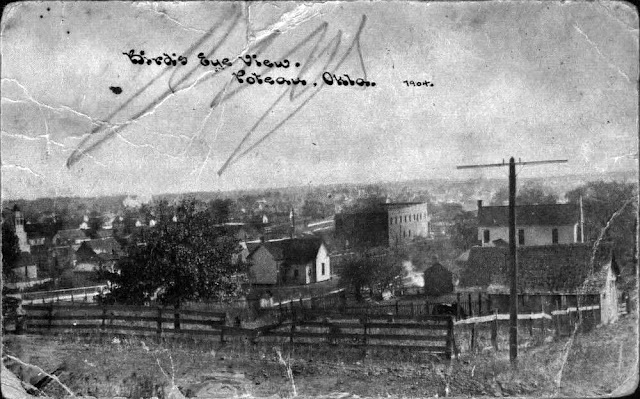By 1901, the fire that had wiped out the heart of Poteau was a distant memory. Rowdy laughter echoed from the newly constructed Lawson House, located just down the street from the depot between Beard and Fleener. Next door, just past the grocery store, locals stopped in the pool hall to try their hand at four-ball carom billiards or “61 pool”. Even though 8-ball was invented in 1900, it still took several years for it to catch on in Poteau. Located inside of this pool hall was the Frisco Barber Shop owned by J. W. Jones.
The signs of progress were everywhere. The area where the old Fleener Hotel once stood is now filled with construction equipment and supplies. Within the year, a new two-story brick building would house several general stores, all catering to the needs of both Poteau residents and weary travelers. Just behind this building, a new soda bottling plant had been constructed.
Visitors arriving by train might stay at either the Lawson House or the Commercial Hotel, located just across the tracks from the St. Louis and San Francisco Depot. Mrs. W. A. Lister, the proprietor of the Commercial Hotel, was said to have kept one of the best hotels in the area.
Visitors arriving by horse or wagon also had ample accommodations. On the north end of town, off College and Main, a large wagon yard and stables provided a safe place for travelers to park their wagons and rest their horses. A restaurant located on the wagon yard offered several home cooked meals as well. Towards the south end of town, a large livery stable offered travelers another place to rest their horses.
W. A. Welch and Company continued to run a thriving dry goods business, as did B. A. McDonald. John C. Earl, a prominent Poteau Lawyer and Neal and Bagwell, Attorneys-at-law, both held offices off West Main Street (St. Louis and San Francisco Avenue, known today as Broadway). Daniel and Miller were the proprietors of the People’s Drug Store, also located off West Main. Other business located on the west side of the St. Louis and San Francisco tracks included three restaurants, a corn storage company, a hand printing company, a blacksmith shop, a photo shop and tent, a hardware and furniture store, and several warehouses.
 |
| The Welch General Store, late 1800s |
 |
| The Welch General Store, 1905 |
While development along the west side of the St. Louis and San Francisco tracks was booming, it was slow progress compared to development towards the east and along Dewey Avenue.
After the McKenna building was completed in 1899, development along Dewey Avenue progressed at a rapid pace. In 1900, the second brick structure was built on the southeast corner of Dewey and McKenna. This two-story building housed a jewelry and drug store and a grocery store. By 1901, the entire block between McKenna and Witte following the brick structure was filled with businesses. Among those businesses were several offices, two barbershops, a restaurant, a meat market, and a poolroom.
Along Dewey Avenue, businesses mingled with homes. Historically, before the arrival of the Kansas City Southern, this area had been home to agricultural farms and large manor homes. As development along Dewey progressed, these farms and homes slowly started to disappear.
Just prior to the establishment of the Bank of Poteau, two large, stately homes stood on the corner of Dewey and McKenna. These older homes were sandwiched between a newly developed office building and drugstore. As Poteau grew, scenes like this were common.
The Bank of Poteau was chartered March 7, 1901 and was the first bank in Poteau. It was capitalized with $25,000 and showed a profit of $4,694 for the first year. In 1902, the homes that were located on the corner of Dewey and McKenna were purchased and torn down to make way for a new bank building. In 1904, the Bank of Poteau changed its name to The National Bank of Poteau.
Ed McKenna, a prominent Poteau resident, served as the president of the bank from 1901 through 1913. The salary for the Cashier (bank manager) in 1902 was $85 per month. In 1904, when the bank was nationalized, the bookkeeper's salary was $25 per month.
For over 100 years, the Bank of Poteau has been a staple of Poteau Business. After the 1904 nationalization of the bank and the subsequent name change, the bank changed names again in 1919 to Central State Bank. Three years later, in 1922, the bank would change names one last time. Today, this bank is still known as the Central National Bank.
Along East Main, business was still in full swing. Unaffected by the fire of 1899, Hotel Eastern remained the oldest hotel in Poteau. Further to the north, the Brehm Bakery continued to thrive, serving many delicious treats to the residents of Poteau. The Amos Bros Handle Company, located ¼ northeast of the St. Louis and San Francisco Depot, had expanded operations and remained the largest industrial company in the area.
Other industries included the R. S. Page Lumber Company and an unnamed brick company. Both of these companies were desperately needed as Poteau’s growth continued to skyrocket. The R. S. Page Lumber Company was located between Rogers and Dewey, behind the several storefronts that had been established on Dewey. The Brick Company had kilns that were located on the northeast corner Parker and Witte.
 |
| Page Lumber Co., 1930s |
Towards the other end of town, along the Kansas City, Pittsburg & Gulf Railroad, other businesses were established. The two-story Park Hotel offered some of the finest lodging in the area, and boasted of having an in-room lunch counter. Across Parker Avenue, a large lodging house provided long-term accommodations for people who needed to remain in the area for a while. There was also a restaurant and meat market in this area.
 |
| General Mercantile Store along the old settlement near the KCS tracks, late 1800s. This store remained in business until around 1910. |
Cotton and corn remained the largest agricultural industries. Large cotton platforms were erected along the sides of both the St. Louis and San Francisco and Kansas City Southern railroads. Several buildings were constructed to store corn. Along the St. Louis and San Francisco, a large stockyard was also established to keep cattle and other animals.
Within the town-site of Poteau, the McKenna-Terry Coal Company owned and operated a small slope off Cavanal. The Slope was opened in the year 1903. The coal averages 24 inches thick. The slope was driven down 300 feet, and consisted of four entries. A large air shaft measuring 28 feet in depth and 7 by 7 feet in size supplied fresh air to the miners. There was an average of 14 men and boys employed in and around this mine. The production of coal per year averaged 557 tons, with most of that being produced in the latter half of the year.
There was no power equipment at this mine, the coal having been hoisted by mule power. Ventilation was had by means of a furnace. This mine was only run during the winter months, and the coal disposed of for purposes in the town of Poteau.
During the early 1900’s, coal was an extremely important industry in and around Poteau. Due to this, and the increasing population of the area, new railroad lines were constructed and changes in the existing railroads happened on an almost yearly basis.
The Poteau Valley Railroad was incorporated on October 19, 1900. The railroad ran from Shady point to Calhoun. The total distance the railroad covered was 6.59 miles.
P. D. Sheehan has been appointed trainmaster on the second and third districts of the Kansas City Southern. His Headquarters was in Poteau, Indian Territory, in 1900.
In 1900, The Kansas City, Pittsburg and Gulf Railroad Company (K.C.P. & G.) was acquired by the Kansas City Southern Railway.
 |
| Map of Poteau, 1901, west side of Frisco Tracks, Copyright Eric Standridge |
 |
| Map of Poteau, 1901, east side of Frisco Tracks, Copyright Eric Standridge |










No comments:
Post a Comment